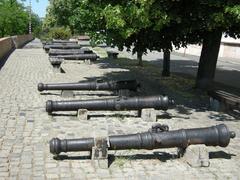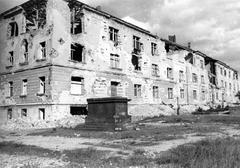
Military History Institute and Museum Budapest: Visiting Hours, Tickets, and Comprehensive Guide
Date: 14/06/2025
Introduction
Located in Budapest’s UNESCO-listed Buda Castle District, the Military History Institute and Museum stands as a vital institution safeguarding Hungary’s military heritage. Housed in the neoclassical Nándor Barracks, which dates back to the 1830s, the museum provides an immersive journey through the country’s military evolution—from medieval times, through periods of revolution, world wars, the Cold War, and into the modern era (bookinbudapest.com; militaria.hu). With over 100,000 artifacts, the museum not only preserves but also interprets Hungary’s military history, offering visitors an unrivaled educational and cultural experience.
Strategically perched atop Buda Castle Hill, the museum is surrounded by other historic landmarks like Matthias Church and the Mary Magdalene Tower, making it an essential stop for anyone exploring Budapest’s rich past. The museum’s exhibitions, research activities, and commemorative programs foster a deeper understanding of the sacrifices and achievements of Hungarian soldiers, while practical visitor amenities ensure a welcoming and accessible environment.
Guide Contents
- The Museum’s History and Architectural Legacy
- Foundation, Mission, and Collection Development
- Hungary’s Major Military Events as Reflected in the Museum
- 1848–49 Revolution and War of Independence
- World Wars and the Interwar Years
- The Cold War and Post-Communist Transition
- Collections and Research
- Restoration, Modernization, and Museum Relocation
- Visitor Information: Hours, Tickets, Accessibility, and Travel Tips
- Exhibition Highlights and Notable Artifacts
- Educational Programs, Guided Tours, and Public Events
- Nearby Attractions and Tips for Visitors
- Frequently Asked Questions (FAQ)
- Visual Highlights
- Conclusion: Why Visit the Military History Institute and Museum?
- References and Further Reading
The Museum’s History and Architectural Legacy
The Military History Institute and Museum—Hadtörténeti Intézet és Múzeum—is situated in the historic Nándor Barracks. Initially built in the 1830s for military purposes, its neoclassical design features robust stonework and symmetry, reflecting its defensive origins (bookinbudapest.com). The building has witnessed and survived the 1848–49 Revolution, the two World Wars, and subsequent reconstructions. Today, it stands not only as an architectural monument but as a keeper of Hungary’s turbulent military history.
Foundation, Mission, and Collection Development
Founded in 1918, the museum’s original mission was to collect, preserve, and present the artifacts and stories of Hungary’s military past (militaria.hu). Its rapidly growing collections span from medieval artifacts to contemporary military memorabilia, including weaponry, uniforms, regimental colors, medals, archival documents, photographs, and personal effects. The institution has grown into a leading research center, supporting academic studies and international collaborations.
Hungary’s Major Military Events as Reflected in the Museum
1848–49 Revolution and War of Independence
The Nándor Barracks and the Buda Castle District played a central role in this pivotal conflict. The museum’s displays from this era include uniforms, weaponry, and personal accounts, chronicling the struggle for Hungarian autonomy (bookinbudapest.com).
World Wars and the Interwar Years
During World War I, the barracks served as a mobilization and training center. The museum presents rare photographs, military orders, and personal diaries from the period, as well as artifacts related to the Treaty of Trianon. World War II collections include equipment from both Axis and Soviet armies, and testimonies from the Siege of Budapest (militaria.hu).
The Cold War and Post-Communist Transition
After WWII, the barracks were partially used by Soviet troops. The museum’s Cold War section features uniforms, vehicles, and communications equipment from the era. The fall of communism in 1989 allowed the museum to present a more open, critical interpretation of Hungary’s 20th-century military history.
Collections and Research
With over 100,000 artifacts, the museum’s collection is among Central Europe’s largest. Key components include:
- Weaponry: Swords, firearms, artillery, and armored vehicles from various eras.
- Uniforms and Insignia: Displaying the evolution of Hungarian military dress.
- Flags and Banners: Over 1,000 regimental and national flags, some centuries old.
- Numismatics: Medals, coins, and military decorations.
- Archival Materials: Maps, plans, photos, and correspondence.
The research division also publishes the Quarterly of Military History and supports international conferences (militaria.hu).
Restoration, Modernization, and Museum Relocation
Recent years have seen significant investments in restoration and modernization. Interactive displays, multimedia presentations, and educational workshops now complement the historic setting. In 2025, the museum will relocate to a modern facility on Disz Square, Buda Castle, promising enhanced accessibility and expanded exhibition space (budacastlebudapest.com).
Visitor Information: Hours, Tickets, Accessibility, and Travel Tips
- Visiting Hours: Open Tuesday–Sunday, 10:00 AM–6:00 PM; closed on Mondays and major public holidays.
- Tickets: Adults ~2,000–3,000 HUF; discounts for students, seniors, children, groups, and families. Entry is free on Hungarian national holidays (March 15, August 20, October 23).
- Where to Buy: Tickets can be purchased on-site or online via the official museum website.
- Accessibility: Wheelchair access is available in most areas; ramps and elevators are provided. Assistance can be arranged in advance.
- Getting There: Easily accessible via public transport—take the Castle Bus (line 16) or funicular from Clark Ádám Square. Parking is limited; walking or transit is recommended.
Exhibition Highlights and Notable Artifacts
- Hungarian Hussar Uniforms: Famed light cavalry attire.
- Cannonballs from the 1849 Siege: Symbolize the fight for independence.
- Recovered WWII Artifacts: Items returned to Hungary after being lost during the war.
- The Armoury: Interactive weapon display from the 10th century to the present.
Educational Programs, Guided Tours, and Public Events
- Guided Tours: Available in Hungarian and English; advance booking recommended.
- Audio Guides: Multi-language guides enhance self-guided visits.
- Special Events: Includes Night of Museums (June), temporary exhibitions, and commemorations.
- Educational Initiatives: Workshops and programs for schools, families, and adult learners.
Nearby Attractions and Tips for Visitors
- Buda Castle District: Walkable to Matthias Church, Fisherman’s Bastion, Budapest History Museum, and Hungarian National Gallery.
- Dining and Photography: Numerous restaurants and panoramic city views make for an enjoyable outing.
- Travel Tip: Allow 2–3 hours for a full visit; check the website for latest exhibitions and events.
Frequently Asked Questions (FAQ)
Q: What are the Military History Institute Budapest visiting hours?
A: Tuesday to Sunday, 10:00 AM–6:00 PM. Closed Mondays and public holidays.
Q: How much are tickets?
A: Adult tickets are typically 2,000–3,000 HUF; discounts available for children, students, seniors, and families.
Q: Is the museum accessible for visitors with disabilities?
A: Yes, with ramps, elevators, and accessible restrooms.
Q: Are guided tours available?
A: Yes, in Hungarian and English; audio guides and group tours can be booked in advance.
Q: Where are the Military Historical Archives located?
A: The archives and library remain in Budapest, separate from the main museum (now moving to Székesfehérvár).
Visual Highlights
The historic facade of the Nándor Barracks, former home to the Military History Institute and Museum.
Exhibit showcasing the famed Hungarian Hussar cavalry uniforms.
Conclusion
The Military History Institute and Museum is an essential destination for anyone seeking to understand Hungary’s military past and its influence on national identity. Its comprehensive collections, interactive exhibitions, and commitment to impartial scholarship offer visitors a profound and engaging experience. With its strategic location in the Buda Castle District and evolving facilities, the museum remains accessible and relevant for all audiences. Before your visit, consult the official museum website for the latest details on exhibitions, ticketing, and special events.
Whether you are a history buff, a student, a family, or a cultural traveler, the Military History Institute and Museum invites you to explore, reflect, and connect with Hungary’s military heritage.
References and Further Reading
- Military History Institute and Museum Budapest: Visiting Hours, Tickets & Historical Highlights, 2025, Book in Budapest (bookinbudapest.com)
- Military History Institute Budapest: Visiting Hours, Tickets, and Historical Insights, 2025, Hungarian Military History Museum (militaria.hu)
- Military History Institute and Museum in Székesfehérvár: Visiting Hours, Tickets, and Exhibitions Guide, 2025, Just Budapest (justbudapest.com)
- Visitor Experience and Programs, 2025, Military History Institute Budapest Official Website (militaria.hu)
- Military History Institute Budapest relocation information, 2025, Buda Castle Budapest (budacastlebudapest.com)









































































































































































